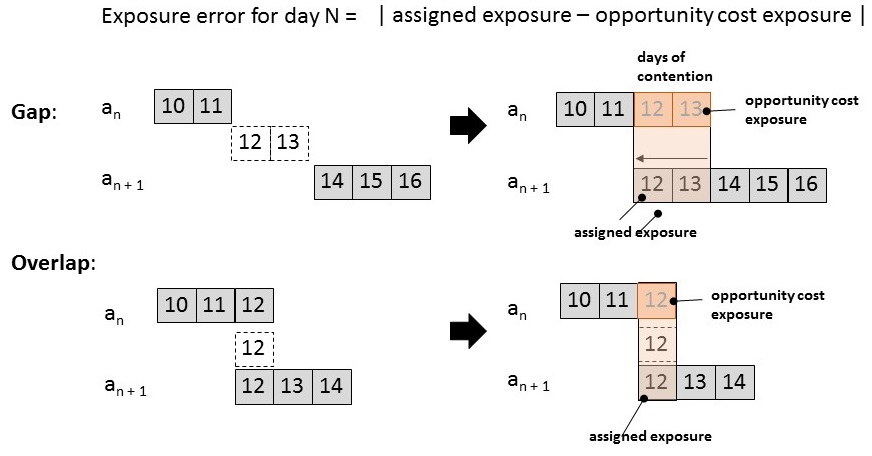Calculations and Algorithms
by Kevin Garwood
Exposure Measurement Error Calculations
ALGAE's cleaning process will ensure that study members occupy exactly one location for each day of their exposure time frames. Gaps and overlaps may occur in the administrative records that are used to create residential address histories. These two types of problems make it uncertain where they may have lived.If an exposure day is affected by a correction for a gap or an overlap, ALGAE assigns an exposure measurement error that is based on the difference between two locations: the address that cleaning assigned and the address that could have otherwise been used.

Percent Error Calculations
ALGAE conducts exposure assessment in different ways, and then compares corresponding results between pairs of them. See the section Aggregate Daily Exposure Methods Using Different Methods.

Life Stage Calculations
Calculation of temporal boundaries for life stages
Most of the temporal boundaries for life stages in the early analysis the early life analysis are based on the date of conception, which is calculated as follows:
conception date = birth date - (7 x gestation age at birth in weeks) - 1 day
| Life Stage | Description | Start Date | End Date |
|---|---|---|---|
| T1 | Trimester 1 | conception date |
conception date + 92 days |
| T2 | Trimester 2 | conception date + 93 days |
conception date + 183 days |
| T3 | Trimester 3 | conception date + 184 days |
birth date - 1 day |
| EL | Early life period | birth date |
birth date + 1 year - 1 day |
| YRn | Year n of life | birth date + n years |
birth date + (n + 1) years - 1 day |
Algorithm for fixing life stage boundaries in cases of premature birth
In the early life analysis, if the cohort member has a gestation age at birth of less than 26 weeks, then one or both of T2 or T3 will overlap with the EL period. In order to correct this, we use an algorithm described by the following pseudo-code:If life stage = 'EL' then do not change the start and end dates Else if life stage start date > birth date then assign the life stage null values for its start and end dates Else if life stage end date > birth date then end date = birth date - 1 day
